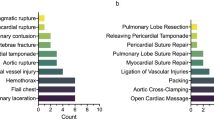Abstract
Purpose
Thoracic injury is a major contributor to morbidity in trauma patients. There is limited data regarding practice patterns of video-assisted thoracoscopic surgery (VATS) across trauma-accredited hospitals in the United States. We hypothesized that early VATS remains underutilized affecting patient outcomes.
Method
We evaluated a cohort of patients who underwent non-urgent thoracic surgical intervention for trauma from the ACS-TQIP database in 2017 excluding patients who were discharged within 48-h or died within 72-h. We selected patients who underwent partial lung resection and decortication to assess the effect of early (day 2–5) versus late VATS. Univariate followed by multivariate regression analyses were utilized to evaluate the independent impact of timing.
Results
Over 12 months, 997,970 patients were admitted to 850 trauma-accredited centers. Thoracic injury occurred in 23.5% of patients, 1% of whom had non-urgent thoracic procedures. A total of 406 patients underwent VATS for pulmonary decortication with/out partial resection, 39% were Early VATS (N = 159) compared to 61% late VATS (N = 247). Both groups had comparable demographics and comorbidities with exception of a higher ISS score in the late surgical group (17.9 ± 9.8 vs 14.9 ± 7.6, p < 0.01). The late VATS patients’ group had higher rates of superficial site infection, unplanned intubation, and pneumonia. Early VATS was associated with shorter ICU stay and HLOS. Multivariate analysis confirmed the independent effect of surgical timing on postoperative complications and LOS. The conversion rate from VATS to thoracotomy was 1.9% in early group compared to 6.5%, p = 0.03. There was no difference in surgical pattern among participating facilities.
Conclusion
Despite established practice guidelines supporting early VATS for thoracic trauma management, there is underutilization with less than half of patients undergoing early VATS. Early VATS is associated with improved patient outcomes.


Similar content being viewed by others
References
Demirhan R, Onan B, Oz K, et al. Comprehensive analysis of 4205 patients with chest trauma: a 10-year experience. Interact Cardiovasc Thorac Surg. 2009;9:450–3. https://doi.org/10.1510/icvts.2009.206599.
O’Connor JV, Adamski J. The diagnosis and treatment of non-cardiac thoracic trauma. J R Army Med Corps. 2010;156:5–14. https://doi.org/10.1136/jramc-156-01-02.
Bayer J, Lefering R, Reinhardt S, et al. Severity-dependent differences in early management of thoracic trauma in severely injured patients—analysis based on the TraumaRegister DGU®. Scand J Trauma Resusc Emerg Med. 2017;25:10. https://doi.org/10.1186/s13049-017-0354-4.
Pape HC, Remmers D, Rice J, et al. Appraisal of early evaluation of blunt chest trauma: development of a standardized scoring system for initial clinical decision making. J Trauma. 2000;49:496–504. https://doi.org/10.1097/00005373-200009000-00018.
Lodhia JV, Konstantinidis K, Papagiannopoulos K. Video-assisted thoracoscopic surgery in trauma: pros and cons. J Thorac Dis. 2019;11:1662–7. https://doi.org/10.21037/jtd.2019.03.55.
Cetindag IB, Neideen T, Hazelrigg SR. Video-assisted thoracic surgical applications in thoracic trauma. Thorac Surg Clin. 2007;17:73–9. https://doi.org/10.1016/j.thorsurg.2007.02.007.
Mowery NT, Gunter OL, Collier BR, et al. Practice management guidelines for management of hemothorax and occult pneumothorax. J Trauma. 2011;70:510–8. https://doi.org/10.1097/TA.0b013e31820b5c31.
Lin HL, Huang WY, Yang C, et al. How early should VATS be performed for retained haemothorax in blunt chest trauma? Injury. 2014;45:1359–64. https://doi.org/10.1016/j.injury.2014.05.036.
Smith JW, Franklin GA, Harbrecht BG, et al. Early VATS for blunt chest trauma: a management technique underutilized by acute care surgeons. J Trauma. 2011;71:102–5. https://doi.org/10.1097/TA.0b013e3182223080 (discussion 105–107).
Patel NJ, Dultz L, Ladhani HA, et al. Management of simple and retained hemothorax: a practice management guideline from the Eastern Association for the Surgery of Trauma. Am J Surg. 2021;221:873–84. https://doi.org/10.1016/j.amjsurg.2020.11.032.
Landreneau RJ, Keenan RJ, Hazelrigg SR, et al. Thoracoscopy for empyema and hemothorax. Chest. 1996;109:18–24. https://doi.org/10.1378/chest.109.1.18.
Liu DW, Liu HP, Lin PJ, et al. Video-assisted thoracic surgery in treatment of chest trauma. J Trauma. 1997;42:670–4. https://doi.org/10.1097/00005373-199704000-00015.
Vassiliu P, Velmahos GC, Toutouzas KG. Timing, safety, and efficacy of thoracoscopic evacuation of undrained post-traumatic hemothorax. Am Surg. 2001;67:1165–9.
Schieren M, Bohmer AB, Lefering R, et al. Impact of body mass index on outcomes after thoracic trauma-A matched-triplet analysis of the TraumaRegister DGU((R)). Injury. 2019;50:96–100. https://doi.org/10.1016/j.injury.2018.09.051.
Chrysou K, Halat G, Hoksch B, et al. Lessons from a large trauma center: impact of blunt chest trauma in polytrauma patients-still a relevant problem? Scand J Trauma Resusc Emerg Med. 2017;25:42. https://doi.org/10.1186/s13049-017-0384-y.
Marini CP, Petrone P, Soto-Sanchez A, et al. Predictors of mortality in patients with rib fractures. Eur J Trauma Emerg Surg. 2019. https://doi.org/10.1007/s00068-019-01183-5.
Huber S, Biberthaler P, Delhey P, et al. Predictors of poor outcomes after significant chest trauma in multiply injured patients: a retrospective analysis from the German Trauma Registry (Trauma Register DGU®). Scand J Trauma Resusc Emerg Med. 2014;22:52. https://doi.org/10.1186/s13049-014-0052-4.
DuBose J, Inaba K, Demetriades D, et al. Management of post-traumatic retained hemothorax: a prospective, observational, multicenter AAST study. J Trauma Acute Care Surg. 2012;72:11–22. https://doi.org/10.1097/TA.0b013e318242e368 (discussion 22–14; quiz 316).
Villavicencio RT, Aucar JA, Wall MJ Jr. Analysis of thoracoscopy in trauma. Surg Endosc. 1999;13:3–9. https://doi.org/10.1007/s004649900886.
Manlulu AV, Lee TW, Thung KH, et al. Current indications and results of VATS in the evaluation and management of hemodynamically stable thoracic injuries. Eur J Cardiothorac Surg. 2004;25:1048–53. https://doi.org/10.1016/j.ejcts.2004.02.017.
Author information
Authors and Affiliations
Contributions
YA, AS, DA, JK, SWL, MBA and EBR were responsible for study design, and data acquisition. LW and JK were responsible for data acquisition and statistical analysis. All authors contributed to drafting the manuscript, revising it critically and provided approval of the final manuscript version.
Corresponding author
Ethics declarations
Conflict of interest
The author declares that they have no conflict of interest.
Supplementary Information
Below is the link to the electronic supplementary material.
Rights and permissions
About this article
Cite this article
Alwatari, Y., Simmonds, A., Ayalew, D. et al. Early video-assisted thoracoscopic surgery (VATS) for non-emergent thoracic trauma remains underutilized in trauma accredited centers despite evidence of improved patient outcomes. Eur J Trauma Emerg Surg 48, 3211–3219 (2022). https://doi.org/10.1007/s00068-022-01881-7
Received:
Accepted:
Published:
Issue Date:
DOI: https://doi.org/10.1007/s00068-022-01881-7




